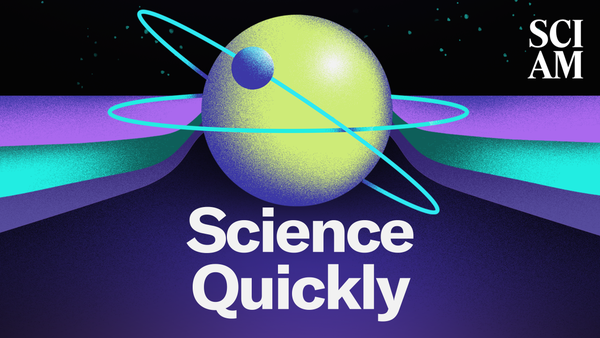
Do You Really Have a Spoonful of Microplastics in Your Brain?
www.scientificamerican.com
February 9, 2025What Weve Learned about Superstrong Shrimp, How Deep Canyons Formed on the Moon, and What Bonobos KnowIn this weeks roundup, were reviewing some animal research, the latest on bird flu and the burden of microplastics on our brain. Anaissa Ruiz Tejada/Scientific AmericanSUBSCRIBE TO Science Quickly[CLIP: Theme music]Rachel Feltman: Happy Monday, listeners! For Scientific Americans Science Quickly, Im Rachel Feltman. Lets kick off the week by catching up on some of the science news you may have missed.[CLIP: Theme music][CLIP: The Farmhouse by Silver Maple]On supporting science journalismIf you're enjoying this article, consider supporting our award-winning journalism by subscribing. By purchasing a subscription you are helping to ensure the future of impactful stories about the discoveries and ideas shaping our world today.First, a quick bird flu update. If youre a regular listener, you already know that H5N1 bird flu has been circulating in U.S. cattle for almost a year. Thats been thanks to a type called B3.13. Now a different variant of H5N1 that had been circulating in birds, known as the D1.1 genotype, has shown up in six herds in Nevada. This suggests that our current outbreak involved more than one spillover event, or an instance when a bird transmitted H5N1 to a cow. We dont know when the D1.1 variant hopped over to cattle, or how widely its circulating. People have previously been infected with D1.1, including two severe cases, and NPR reports that scientists have speculated that this genotype might be more dangerous to humans. D1.1 was also responsible for the first U.S. death from H5N1 bird flu, when someone in Louisiana caught it from backyard flocks.Lets move on to some other health news. Last Monday great.[CLIP: Theme music][CLIP: It Doesnt End Here (Instrumental), by Nehemiah Pratt]And speaking of brains, a new observational study suggests that people generally feel their best, at least mentally, in the morning. Based on data from a multiyear study that followed nearly 50,000 people, researchers [CLIP: Theme music][CLIP: None of my Business by Arthur Benson]Regardless of the hour, if you find yourself struggling with something, you might be able to get a hand from a surprising ally: a bonobo. A study published last Monday in the Proceedings of the National Academy of Sciences explores whether our close primate relatives have whats known as theory of mind, or the ability to imagine the mental states of others.To test that, researchers set up an experiment where a human tester sat with a bonobo while another person hid a grape under one of three cups. The tester would then spend about 10 seconds making a show of being unsure which cup the grape was under. When the bonobo had seen the tester watch their colleague place the grape, the animal was slower to point out the treats location and did so less often. But when the tester was blocked from watching the grape be placed, the bonobo were more likely to point out where the fruit was and do so more quickly. In other words, the animal could seemingly comprehend that their human companion didnt have the information needed to complete the task and sought to help them out.In other wild animal news or even aquarium glass. This new study aimed to figure out how these shrimp stay in one piece in the wake of the awesome shock waves they create.Apparently, the mantis shrimps mighty hammer, or dactyl club, has layers of intricate patterns that help protect the small crustaceans. The part of the club that hits its target is covered in mineralized fibers that form something like a herringbone pattern. That gives the club structural integrity when hammer time comes around. But beneath that are twisted fiber bundles that rotate from one layer to the next. Researchers say this design filters out certain frequencies, dampening the stress of the impact and protecting the shrimp from facing the consequences of its actions. In addition to just being really cool, the researchers say, this natural design could help inform the creation of better soundproofing materials and perhaps even protective gear for athletes and soldiers.[CLIP: Theme Music]On the topic of big blasts, new research suggests that a dramatic event could be to blame for two massive canyons on the moon. Vallis Schrdinger and Vallis Planck are roughly 1.7 and 2.2 miles deep, respectively, putting our own planets Grand Canyon to shame with its mere 1.2-mile depth. But while plate tectonics and erosion shaped our beloved Southwest landmark over millions of years, analysis of images and data from NASAs Lunar Reconnaissance Orbiter suggests things happened much more quickly for Schrdinger and Planck. Instead of gradually shifting earth and a river of water, fast-moving streams of rock that resulted from a dramatic cosmic impact carved these lunar pits around 3.8 billion years ago. The scientists behind the study, published last Tuesday in Nature Communications, estimate that the debris ejected in the impact reached speeds of up to about 2,800 miles per hour, hitting the lunar surface with a huge amount of energy and chiseling out the massive canyons in as little as 10 minutes. I guess were just no match for lunar efficiency.[CLIP: Theme Music]Thats all for todays news roundup. If youre wondering why we didnt talk about that asteroid that has a very small chance of colliding with Earth in, like, a decade, dont worry: were going to give you the full 411 on Wednesday.Science Quickly is produced by me, Rachel Feltman, along with Fonda Mwangi, Kelso Harper, Madison Goldberg, Naeem Amarsy and Jeff DelViscio. Shayna Posses and Aaron Shattuck fact-check our show. Our theme music was composed by Dominic Smith. Subscribe to Scientific American for more up-to-date and in-depth science news.For Scientific American, this is Rachel Feltman. Have a great week!
0 Kommentare
·0 Anteile
·37 Ansichten


